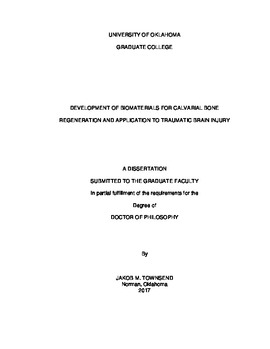| dc.description.abstract | In the treatment of severe traumatic brain injury (TBI), a two-stage surgical intervention is routinely performed. In the first surgery, decompressive craniectomy (DC) is performed to remove a large portion of calvarial bone to allow unimpeded brain swelling. A second surgery termed cranioplasty, usually performed weeks to months later, is then employed to rebuild the cranium. Hydrogels have the potential to revolutionize TBI treatment by permitting a single-stage surgical intervention, capable of exhibiting paste-like handling properties in the pre-crosslinked form for in situ placement to fill any size or shape of defect, remaining pliable during brain swelling, and tuned to regenerate bone after swelling has subsided. The motive of the current dissertation was to achieve the first step in designing a single-stage surgical intervention for treatment of TBI following DC, being the design of a hydrogel capable of regenerating bone within a critical size calvarial defect. The current dissertation first evaluated the use of colloidal hydrogels of hyaluronic acid, hydroxyapatite, and extracellular matrix (ECM) materials demonstrating promise for decellularized cartilage as a material for bone regenerative medicine. A next-generation biomaterial was then developed utilizing a methacrylated solubilized decellularized cartilage hydrogel encapsulating osteoconductive particles, the results of which demonstrated diminished bone regeneration that was speculated to be due to cartilage processing (i.e., solubilization). In the final study, pentenoate-functionalized hyaluronic acid (PHA) hydrogels encapsulating devitalized ECM materials were evaluated and I found that PHA hydrogels encapsulating devitalized tendon (DVT) particles successfully regenerated bone in a critical size calvarial defect. Future studies will be conducted to test the use of the PHA-DVT hydrogel in a rat TBI model to evaluate the use of hydrogels in the treatment of TBI following DC. Ultimately, the current dissertation work successfully developed a hydrogel material that exhibits desirable handling properties in the pre-crosslinked form for surgical placement and adequate bone regeneration after 8 weeks of in vivo implantation, with promising future applications to bone regeneration and application to treatment of TBI. | en_US |
